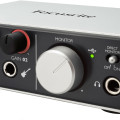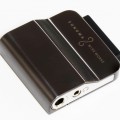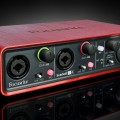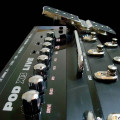The most important piece of hardware in any home studio is the audio interface. The audio interface is the connection between the analog world and digital, and is essential an external sound card. Apart from high-quality analog-to-digital conversion, an audio interface for a guitarist needs a preamp. The preamp brings up the very low signal level coming out of an electric guitar to line level. Without a preamp you would need to increase to input volume on the interface, which at best brings it up proper level with a lot of noise. Other things you could want from an audio interface is connectors for microphones, MIDI connectors and good balanced outputs for monitors.
With this wishlist in mind I set out looking for an audio interface. I was fed up with using my POD X3 Live as an interface, because of its size and the fact that the dry input signal wasn’t really as good as I’d like. My choice fell upon the Focusrite Scarlett 2i4.
Specs
- USB 2.0
- 24 bit / 96 kHz
- 2 combined instrument/microphone inputs (RCA/XLR) with padding and phantom power, with hardware level controls
- Balanced and unbalanced stereo outputs
- MIDI in/out
- Monitor controls (volume level, stereo/mono, dry input/playback mix control)
- Headphone out with hardware volume control
My impressions
The Focusrite Scarlett 2i4 is very impressive even coming right out of the box. It has a pretty red brushed steel casing and the right weight to instill confidence. Once you start to use it it’s even more impressive. For low latency audio in Windows, you need to install Focusrite’s audio drivers, but apart from that getting started is very easy – and in MacOS I’m not even sure if you need the separate drivers.
The Focusrite preamps are renowned for their quality and the biggest reason I went for a Scarlett. The preamps in the 2i4 are very powerful – so powerful that I always need to activate the pad function not to get clipped input from my electric guitar. This fact alone makes me happy I chose the 2i4 and not the 2i2 which lacks padding functionality. There is a lot of gripe about this on audio forums – some people can’t get a non-clipped input signal without rolling off the volume on their guitars – how are you suppose to play metal that way? ;-).
The quality of the input signal is very good, and with a humbucker guitar I get very little background noise. Latency is also very good, even though I can’t use the absolute lowest buffer settings with my current computer without stuttering. There really isn’t much more you can change in the driver, but the dialog shows an easy overview of the input and output latency in milliseconds.
The output of the interface is powerful enough to achieve any kind of volume I need in my home studio, and drives my AKG 671 headphones without problems (which my MacBook didn’t, for instance) – once I realized the big monitor knob really should be labeled “master volume” :-).
The are quite a few controls that affect monitoring – you can choose to monitor the input directly or the output from your DAW, or a mix of those. Since dry input from a guitar is mono, there is a stereo switch that outputs this mono input to both channels. Personally, since I use my computer as an amp sim, monitoring dry is quite useless.
I’ve done most of my testing of this interface using it as a dry input into Reaper, where I apply a VST amp sim (usually one of LePou’s or TSE) and cab impulse response. It hasn’t been without problems, since my computer is starting to get old. With a Core2Duo processer, I just barely manage to record dry and monitor wet with a backtrack running. Switching the amp sims to mono/low quality helps a lot, but I think I need to upgrade pretty soon. This is no fault of the interface, of course :-). Recording with amp sims on my Macbook Air (Core i5) has been no problem at all.
Here’s a sample recording:
[soundcloud id=’83564860′]
So, anything bad? Not really… It annoys me that there’s no on/off button, just because it’s USB powered doesn’t mean I want it on every time I switch on my computer. I think this could have been a whole different review if I’d gotten the 2i2 though – make sure you test properly if you need padded inputs or just get one of the bigger models.





